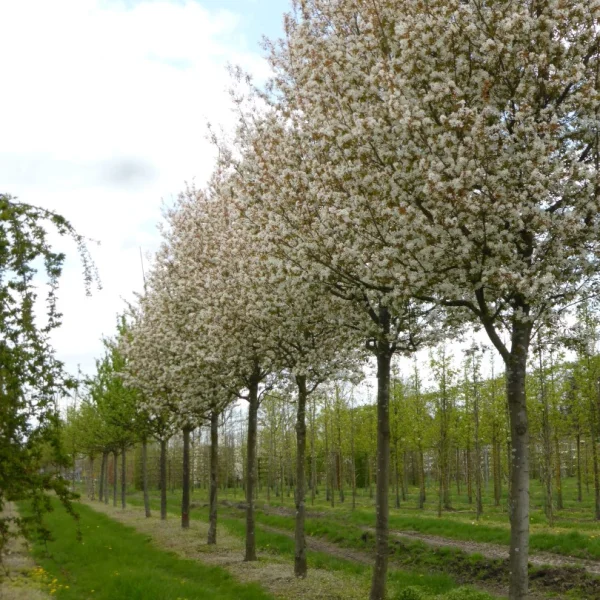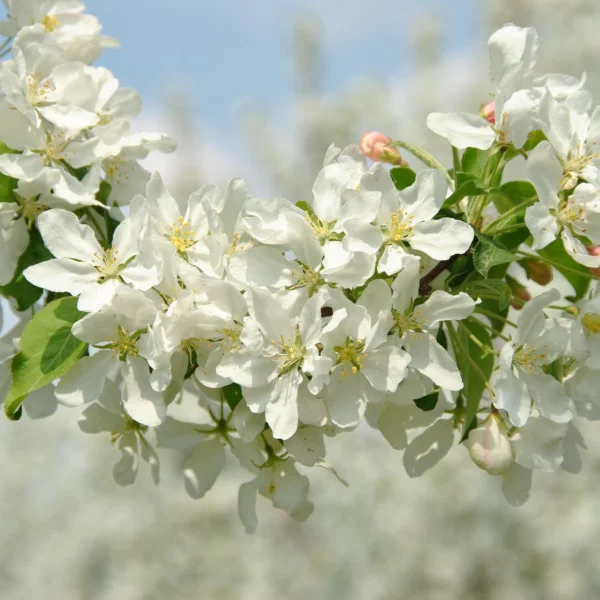Pyrus calleryana 'Chanticleer' – Pyrus calleryana 'Chanticleer'
Rosaceae
Pyrus calleryana 'Chanticleer' – Pyrus calleryana 'Chanticleer'
Cel mai de succes soi de Pyrus calleryana. De înălțime medie, cu o coroană conică îngustă până la ovoidală. Rămâne semnificativ mai îngust decât "Bradford", dar devine din nou mai lat decât "Capital". Înălțime de aproximativ 12 m. Scoarța veche este aspră, de culoare gri-maronie și se desprinde în plăci mici. Frunzele sănătoase, de un verde lucios, rămân pe copac până toamna târziu și au o coloristică de toamnă atractivă, în nuanțe de galben și roșu. Înflorirea este abundentă, iar florile albe sunt dispuse în corimbi de 6 până la 12 împreună. Diametrul florilor este de aproximativ 2 cm. După înflorire, rareori urmează fructele. 'Chanticleer' are rădăcini adânci și se înrădăcinează bine. Potrivit ca solitar și pentru plantarea pe alei și străzi înguste. Preferă un sol neutru sau ușor calcaros. Crește în continuare în soluri sărace. Foarte rezistent la poluarea atmosferică.
Availability
Specifications
Download PDF
Height
8 -12 m
Width
4-6m
Crown
narrow conical to ovoid, half-open crown
Bark and branches
old bark is rough and flaky
Leaf
oval to broad oval, glossy green, 4 - 10 cm
Autumn colour
yellow, red
Flowers
white, in plentiful umbels, April/May
Fruits
round, approx. 1 cm Ø, brown with lighter lenticels
Spines/thorns
None
Toxicity
usually not toxic to people, (large) pets and livestock
Soil type
places little demands
Paving
tolerates paving
Winter hardiness zone
5b (-26,0 to -23,4 °C)
Wind resistance
good, also on the coast
Other resistances
resistant to frost (WH 1 - 6), can withstand wind
Fauna tree
aluable for bees (honey plant), provides food for birds
Application
avenues and broad streets, narrow streets, tree containers, roof gardens, coastal areas, industrial areas, small gardens
Shape
clearstem tree, feathered tree, multi-stem treem
Origin
E.H. Scanlon & Assoc., Olmstead Falls, OH, USA, 1956
Synonyms
Pyrus calleryana 'Stone Hill'
Possibly of interest
Frequently asked questions
Pyrus calleryana 'Chanticleer'
Pyrus calleryana 'Chanticleer' can eventually reach a height of 8 -12 m, depending on the site and climate conditions.
Pyrus calleryana 'Chanticleer' has a average growing and can eventually reach a height of 8 -12 m, depending on the site and climate conditions.
The leaves of Pyrus calleryana 'Chanticleer' turn yellow, red in autumn.
The right time to plant Pyrus calleryana 'Chanticleer' is during the dormancy period. In Western Europe, Pyrus calleryana 'Chanticleer' with root balls can generally be planted from mid-November to late April, although this depends strongly on the climatic conditions and the species of tree.
april.
General
 English
English
 English (United Kingdom)
English (United Kingdom)
 Nederlands
Nederlands
 Nederlands (België)
Nederlands (België)
 Deutsch
Deutsch
 français
français
 čeština
čeština
 polski
polski
 español
español
 română
română
 dansk
dansk
 svenska
svenska
 magyar
magyar
 Türkçe
Türkçe
 slovenčina
slovenčina
 русский
русский
 norsk
norsk










